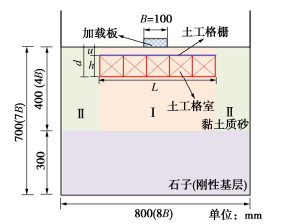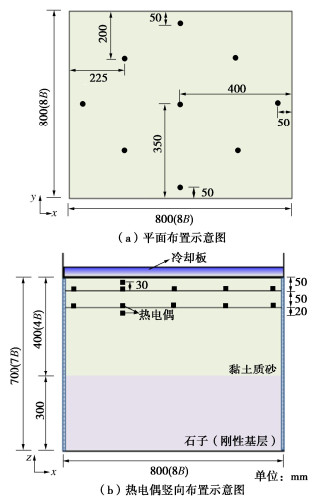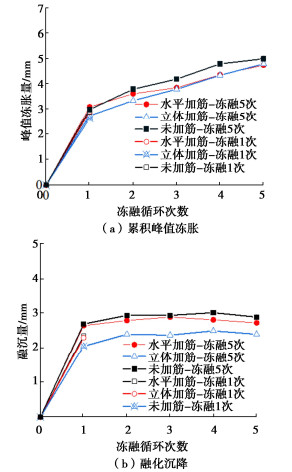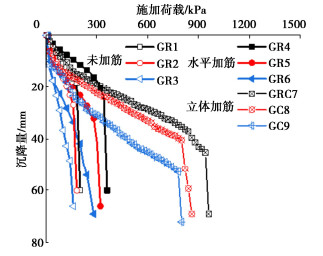Effects of horizontal and three-dimensional reinforcement on frost-heaving and thawing-settlement in seasonally frozen soils
-
摘要: 冻胀融沉是季节性冻土区建筑物破坏的主要原因,实际应用表明,土工合成材料加筋路基具有良好的抗冻融循环损伤能力,然而不同加筋形式的有益影响尚未被量化。针对四川阿坝地区典型季节性冻土,开展了水平及立体加筋土冻融循环试验及平板载荷试验,研究了冻融循环对加筋土和未加筋土力学性能的影响,对比了水平加筋及立体加筋土的防冻胀融沉效果。研究发现:水平加筋和立体加筋均可一定程度上抑制土体的冻胀融沉,提高冻融循环后土体的承载力,抑制冻融循环的弱化作用。立体加筋加固效果优于水平加筋。经过5次冻融循环后,水平加筋使冻胀隆起和融化沉降分别减少5%,6%,立体加筋使冻胀隆起和融化沉降分别减少4%,17%;水平加筋对冻融循环土体的承载力和刚度分别提高75%,29%,立体加筋对冻融循环土体的承载力和刚度分别提高388%,40%。Abstract: The frost heaving and thaw-induced settlement is the primary causes of structural damage in the areas with seasonally frozen soils. Practical applications have demonstrated that the roadbeds reinforced with geosynthetic materials exhibit excellent resistance to cyclic frost-thaw damage. However, the beneficial effects of various forms of reinforcement have not been quantified. To address this gap, the freeze-thaw cycle tests and plate-load tests are conducted on soil samples, horizontally or three-dimensionally reinforced, collected from a representative seasonal frozen soil site in the Aba area, Sichuan Province. The effects of freeze-thaw cycle on the mechanical properties of the reinforced soil are compared to those of unreinforced soil. Additionally, a comparative analysis of the mitigation effects of frost-heaving, thawing-settlement and bearing capacity is performed between the horizontally and three-dimensionally reinforced soils. The study reveals that the frost-heaving and thawing-settlement in the soils can be effectively mitigated by both the horizontal and three-dimensional reinforcements. Moreover, these reinforcement methods enhance the post-freeze-thaw bearing capacity of the soils and counteract the weakening effects of freeze-thaw cycles. Notably, the three-dimensional reinforcement demonstrates a superior reinforcing effect in comparison to the horizontal reinforcement. Following five freeze-thaw cycles, the horizontal reinforcement results in a 5% reduction in the frost-heave and a 6% reduction in the thaw-induced settlement, while the three-dimensional reinforcement yields a 4% reduction in the frost heave and a 17% reduction in the thaw-induced settlement. The horizontal reinforcement enhances the bearing capacity and stiffness of freeze-thaw cyclic soil by 75% and 29%, respectively. In contrast, the three-dimensional reinforcement significantly improves the bearing capacity and stiffness of the freeze-thaw cyclic soils by 388% and 40%, respectively.
-
0. 引言
随着中国交通行业的不断发展,中国桥梁建设水平得到大幅提升,对桥梁跨越能力的要求也不断增长,悬索桥作为所有桥型中跨越能力最大的桥型,越来越成为跨越大江、大河的主要解决方案。但是随着悬索桥跨度的不断增加,锚碇规模急剧扩大,造成锚碇建设成本过高。因此研究锚碇沉井基础的受力变形特性对于悬索桥的锚碇优化设计显得尤为重要。
Alampalli[1]在1994年研究了沉井在承受竖向和水平向荷载时的结构响应;李永盛[2]和李家平等[3]分别在1995年和2005年通过模型试验探讨了沉井基础的变形机制和破坏失稳形式;穆保岗等[4]在2017年通过模型试验研究了水平荷载长期作用下沉井变位的特性;Liu等[5]在2019年通过模型试验结合数值模拟分析研究了重力式锚碇的稳定性。
本文首先进行了在分级水平荷载下的沉井在砂箱中的模型试验,然后基于PLAXIS 3D软件建立了有限元模型,并分析了沉井的位移及沉井前侧和沉井底部的土压力,研究了水平荷载条件下沉井的受力变形规律。
1. 依托工程及模型试验
本文依托南京仙新路大桥北锚碇沉井工程,沉井长度为70 m,宽度为50 m,高度为49.5 m。该工程地基土以粉砂和中砂为主。
本试验采用的模型槽平面尺寸为4.0 m×2.0 m,高1.0 m。地基土采用中砂,其相对密度为2.68,最大孔隙比0.881,最小孔隙比0.463,不均匀系数3.89,曲率系数0.92。模型试验分层填筑地基土,控制每层填土的厚度为0.1 m,最终得到地基土的干密度为1.55 g/cm3,含水率0.63%,相对密实度为59.61%,内摩擦角为34.5°(快剪)。
沉井模型平面尺寸为0.7 m×0.5 m,高0.495 m,由厚度为22 mm的钢板焊接而成,试验过程将沉井看成刚体,不考虑沉井自身的变形,为模拟沉井与土体相互作用的界面,通过在沉井表面黏2~3 mm的砂粒实现[6],如图1所示。
模型试验中设计荷载为62kg,本文中水平荷载分级施加,每级荷载为设计荷载的~0.5倍,试验过程中每级荷载施加持续15 min直至土体破坏(土体破坏表现为沉井盖板处的位移急剧增大),沉井加载示意图如图2所示。
2. 有限元分析
本研究建立的有限元模型完全基于模型试验,土体及沉井的单元形状均为四面体十节点实体单元,数值模型的网格如图3所示。
砂土的本构模型采用土体硬化(HS)模型,土层参数[7]取值见表1。
表 1 土层参数Table 1. Soil parameters土层 γ /(kN·m-3)e Es /MPaErefoed /MPaEref50 /MPaErefur /MPac′ φ′ /(°)ψ /(°)m 砂土 15.6 0.723 10.2 10.2 10.2 30.6 0 34.5 0 0.5 注: γ 为砂土的重度;e 为砂土的孔隙比;Es 为砂土的压缩模量;Erefoed 为砂土的主固结加载切线刚度;Eref50 为砂土的标准三轴排水试验割线刚度;Erefur 为砂土的卸载重加载刚度;c′ 为砂土的有效黏聚力;φ′ 为砂土的有效摩擦角;ψ 为砂土的膨胀角;m 为砂土的刚度应力水平相关幂值。3. 试验结果与有限元结果对比
3.1 沉井顶部位移
在沉井盖板顶部设置3个位移测量点A、B、C。在位移测量点上放置位移靶标,采用TH-ISM-ST机器视觉测量仪对靶标位移进行测量,分辨率为0.01 mm,靶标布置如图4。
模型试验和数值模拟的位移对比如图5所示,由图易知,模型试验和数值模拟的靶标位移较为一致,本文中取水平位移随设计荷载增加而不断增加的线弹性阶段为水平承载力极限值[4],即安全系数取值为4。
3.2 沉井前侧壁土压力随施加荷载变化
在沉井前侧设置8个土压力盒,布置如图6所示,由于土压力盒对称分布,且沉井左右侧完全对称,因此取沉井左右两侧土压力盒平均值作为最终结果,结果如图7所示,其中模型试验中3号及3'号土压力盒数据较差,本文中已舍弃,余下的沉井前侧土压力盒数据和数值模拟结果较吻合。
3.3 沉井前侧壁土压力随施加荷载变化
在沉井底部设置12个土压力盒,布置如图8所示,同理,取沉井左右两侧土压力盒平均值作为最终结果,结果如图9所示,其中8号及8'号土压力盒数据较差,本文中已舍弃,余下的沉井底部土压力盒数据和数值模拟结果对比,发现当施加荷载/设计荷载的值小于等于4时较一致,当其值大于4之后,二者的结果相差较大。
4. 结论
本文在已有的研究基础上,通过开展模型试验和数值模拟计算,得到水平荷载下沉井的受力变位特性,主要得出以下结论:
(1)对锚碇沉井基础在砂土中的受力变位特性进行了试验研究和有限元分析,结果显示,水平荷载下锚碇沉井基础在砂土中的破坏模式为倾覆破坏,且安全系数远大于2,说明现阶段规范[8]中锚碇设计较为保守,有进一步的优化空间。
(2)通过PLAXIS 3D软件建立了锚碇沉井基础的有限元模型,采用应变硬化的本构模型,结果表明模型试验的结果和有限元模型计算的结果较为一致,说明数值建模过程中的土体本构模型及参数取值可靠,表明PLAXIS 3D软件能够较好的模拟锚碇沉井在砂土中的受力变形行为。
上述模型试验和有限元分析,只是针对水平荷载条件下锚碇沉井基础在砂土中的受力特性开展的研究,只考虑了单层干砂的地基土层,尚需更近一步探索。
-
表 1 模型试验组别
Table 1 Details of model tests
试验编号 试验材料 冻融循环次数 温度监测 冻胀监测 平板加载试验 GR-1 未加筋土体 0 否 否 是 GR-2 1 是 是 是 GR-3 5 是 是 是 GR-4 土工格栅水平加筋土体 0 否 否 是 GR-5 1 是 是 是 GR-6 5 否 是 是 GC-7 土工格室立体加筋土体 0 否 否 是 GC-8 1 是 是 是 GC-9 5 否 是 是 -
[1] 孙静, 公茂盛, 熊宏强, 等. 冻融循环对粉砂土动力特性影响的试验研究[J]. 岩土力学, 2020, 41(3): 747-754. https://www.cnki.com.cn/Article/CJFDTOTAL-YTLX202003004.htm SUN Jing, GONG Maosheng, XIONG Hongqiang, et al. Experimental study of the effect of freeze-thaw cycles on dynamic characteristics of silty sand[J]. Rock and Soil Mechanics, 2020, 41(3): 747-754. (in Chinese) https://www.cnki.com.cn/Article/CJFDTOTAL-YTLX202003004.htm
[2] JIE H, YAN J. Use of geosynthetics for performance enhancement of earth structures in cold regions[J]. Sciences in Cold and Arid Regions, 2013, 5(5): 517. doi: 10.3724/SP.J.1226.2013.00517
[3] ZHAO R F, ZHANG S N, GAO W, et al. Factors effecting the freeze thaw process in soils and reduction in damage due to frosting with reinforcement: a review[J]. Bulletin of Engineering Geology and the Environment, 2019, 78(7): 5001-5010. doi: 10.1007/s10064-018-1430-3
[4] SAVAGE B M. Use of geogrids for limiting longitudinal cracking in roads on permafrost[R]. Alaska: State of Alaska, Department of Transportation and Public Facilities, 1991.
[5] 苏艺, 许兆义, 王连俊. 青藏高原多年冻土区铁路加筋路堤的变形特征研究[J]. 岩土工程学报, 2004, 26(1): 115-119. http://cge.nhri.cn/cn/article/id/11349 SU Yi, XU Zhaoyi, WANG Lianjun. Study on deformation characters of reinforced embankment in permafrost regions of Qinghai-Tibet Railway[J]. Chinese Journal of Geotechnical Engineering, 2004, 26(1): 115-119. (in Chinese) http://cge.nhri.cn/cn/article/id/11349
[6] 陈榕, 王喜强, 郝冬雪, 等. 季节性冻土中土工格栅加筋特性试验研究[J]. 岩土工程学报, 2019, 41(6): 1101-1107. doi: 10.11779/CJGE201906014 CHEN Rong, WANG Xiqiang, HAO Dongxue, et al. Experimental investigation on reinforced characteristics of geogrids in seasonal frozen soil[J]. Chinese Journal of Geotechnical Engineering, 2019, 41(6): 1101-1107. (in Chinese) doi: 10.11779/CJGE201906014
[7] HENRY K, OLSON J P, FARRINGTON S, et al. Improved performance of unpaved roads during spring thaw[R]. Vicksburg: US Army Corps of Engineers, Engineer Research and Development Center. 2005.
[8] POKHAREL S K, MARTIN I, NOROUZI M, et al. Validation of geocell design for unpaved roads[C]//Proceedings of Geosynthetics 2015, Oregon, 2015.
[9] HUANG M, LIN C, POKHAREL S K, TURA A, et al. Model tests of freeze-thaw behavior of geocell-reinforced soils[J]. Geotextiles and Geomembranes, 2021, 49: 669-687.
[10] CHEN J F, GUO X P, SUN R, et al. Physical and numerical modelling of strip footing on geogrid reinforced transparent sand[J]. Geotextiles and Geomembranes, 2021, 49(2): 399-412. doi: 10.1016/j.geotexmem.2020.10.011




 下载:
下载:
















